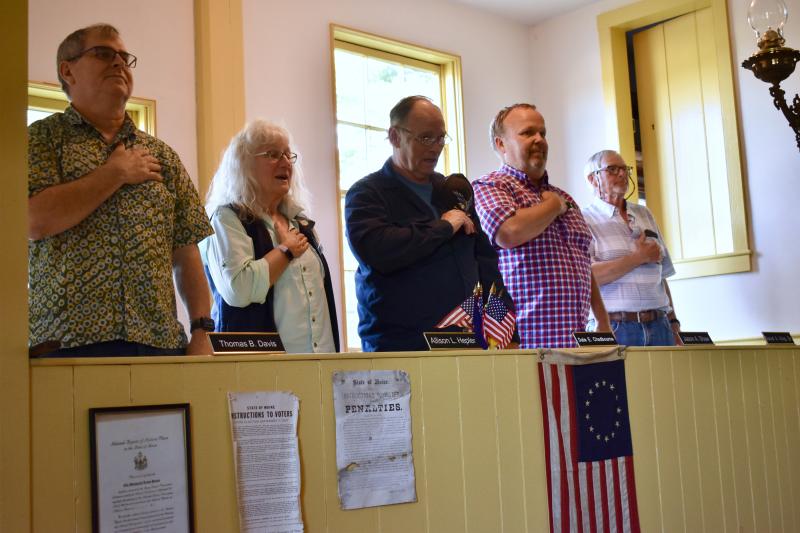Meeting in Woolwich’s 1837 Town House carries on tradition
 Roger Brawn, left, and Chairman David King Sr. meet on the steps of the 1837 Town House. PHIL DI VECE/Wiscasset Newspaper
Roger Brawn, left, and Chairman David King Sr. meet on the steps of the 1837 Town House. PHIL DI VECE/Wiscasset Newspaper
 Saying the Pledge of Allegiance are selectmen, from left, Tommy Davis, Allison Hepler, Dale Chadbourne, Jason Shaw and Chairman David King Sr. PHIL DI VECE/Wiscasset Newspaper
Saying the Pledge of Allegiance are selectmen, from left, Tommy Davis, Allison Hepler, Dale Chadbourne, Jason Shaw and Chairman David King Sr. PHIL DI VECE/Wiscasset Newspaper
 Selectman Allison Hepler stands beside “The Sailors’ and Soldiers Monument” at Laurel Grove Cemetery. File photo
Selectman Allison Hepler stands beside “The Sailors’ and Soldiers Monument” at Laurel Grove Cemetery. File photo
 Roger Brawn, left, and Chairman David King Sr. meet on the steps of the 1837 Town House. PHIL DI VECE/Wiscasset Newspaper
Roger Brawn, left, and Chairman David King Sr. meet on the steps of the 1837 Town House. PHIL DI VECE/Wiscasset Newspaper
 Saying the Pledge of Allegiance are selectmen, from left, Tommy Davis, Allison Hepler, Dale Chadbourne, Jason Shaw and Chairman David King Sr. PHIL DI VECE/Wiscasset Newspaper
Saying the Pledge of Allegiance are selectmen, from left, Tommy Davis, Allison Hepler, Dale Chadbourne, Jason Shaw and Chairman David King Sr. PHIL DI VECE/Wiscasset Newspaper
 Selectman Allison Hepler stands beside “The Sailors’ and Soldiers Monument” at Laurel Grove Cemetery. File photo
Selectman Allison Hepler stands beside “The Sailors’ and Soldiers Monument” at Laurel Grove Cemetery. File photo
The Woolwich selectboard kept up its yearly tradition of meeting in the 1837 Town House when the board reopened the historic building at the corner of Old Stage and Dana Mill roads. The agenda Wednesday evening, June 21 was a light one, although earlier in the afternoon the board began negotiations with Philip Baker to buy a vacant lot he owns across from the municipal building.
Selectman Jason Shaw called the discussion with Baker a positive one. If the details can be worked out, the board would hold a special town meeting in July to consider the purchase. Chairman David King Sr. said the lot would provide some much-needed additional parking for the municipal building and firehouse; it would also eliminate the problem of people parking on the side of the road when the present parking lots are full.
Resident Roger Brawn asked if the town might help maintain the veteran graves at Laurel Grove Cemetery on Middle Road (Route 127). “We have a large number of veterans interred there and some of the memorial stones need resetting,” said Brawn, adding the grounds needed some attention as well. Years ago, the legislature passed a law requiring communities to maintain graves of Maine’s veterans. Brawn, president of Laurel Grove Cemetery Association, told the selectboard the organization hopes to raise some needed funds privately and possibly get other needed monies from the town. “We realize the town budgets are done for this year, but next year perhaps the town can help our cause,” said Brawn.
“We can put it on the town meeting warrant, the voters will have to decide,” responded King, adding that voters had rejected a similar request several years back. Selectman Allison Hepler said she would be willing to work with Brawn in hopes of working out a proposal.
According to Wiscasset Newspaper archives, there are 71 veterans buried in Laurel Grove Cemetery from wars as far back as the War of 1812. The grounds are also home to “The Sailors’ and Soldiers Monument,” an eight-foot-tall granite column erected Oct. 12, 1941 to honor the men and women who served their country during the Civil War, the Spanish-American War and World War I. In 2011, the monument was re-dedicated by the community to include World War II, Korean War, Vietnam War, Gulf War and Global War on Terror veterans.
In other business, the board authorized the chairman to sign off on a $10,900 Community Resilience Grant. When asked what the monies would be used for, Hepler said to update the town’s hazardous mitigation plan, and create for residents a kitchen magnet that lists emergency telephone numbers and other information.
At the meeting’s start, King said the Town House was built with monies the community received from the federal government as the result of the liquidation of the National Debt by President Andrew Jackson. Woolwich chose to use its $800 share which was administered by the state to buy land and build the town hall, which has always been painted its distinctive yellow color. The location was chosen because it is geographically the center of town. “Way back then the Old Stage Road went right through the middle of Woolwich. It was the Route 1 of its time,” King said. Woolwich held its annual town meetings there from 1838 to 1951. When the building got too crowded, selectmen moved the town meeting location to the elementary school on Nequasset Road where town meeting is still held and voting takes place on Election Day.





























